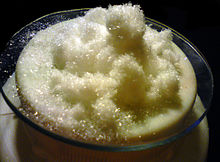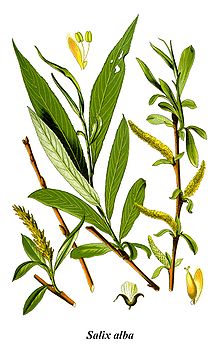Salicylic acid
| |||

| |||
| Names | |||
|---|---|---|---|
| Preferred IUPAC name
2-Hydroxybenzoic acid[1] | |||
| Identifiers | |||
3D model (
JSmol ) |
|||
| ChEBI | |||
| ChEMBL | |||
| ChemSpider | |||
| DrugBank | |||
ECHA InfoCard
|
100.000.648 | ||
| EC Number |
| ||
IUPHAR/BPS |
|||
| KEGG | |||
PubChem CID
|
|||
RTECS number
|
| ||
| UNII | |||
CompTox Dashboard (EPA)
|
|||
| |||
| |||
| Properties | |||
| C7H6O3 | |||
| Molar mass | 138.122 g/mol | ||
| Appearance | Colorless to white crystals | ||
| Odor | Odorless | ||
| Density | 1.443 g/cm3 (20 °C)[2] | ||
| Melting point | 158.6 °C (317.5 °F; 431.8 K) | ||
| Boiling point | 211 °C (412 °F; 484 K) at 20 mmHg[2][3] | ||
| Sublimes at 76 °C[3] | |||
| Solubility | Soluble in oil of turpentine, toluene
| ||
| Solubility in benzene | |||
| Solubility in chloroform | |||
| Solubility in methanol |
| ||
| Solubility in olive oil | 2.43 g/100 g (23 °C)[3] | ||
| Solubility in acetone | 39.6 g/100 g (23 °C)[3] | ||
| log P | 2.26 | ||
| Vapor pressure | 10.93 mPa[3] | ||
| Acidity (pKa) | |||
| UV-vis (λmax) | 210 nm, 234 nm, 303 nm (4 mg/dL in ethanol)[3] | ||
| −72.23·10−6 cm3/mol | |||
Refractive index (nD)
|
1.565 (20 °C)[2] | ||
| 2.65 D | |||
| Thermochemistry | |||
Std enthalpy of (ΔfH⦵298)formation |
−589.9 kJ/mol | ||
Std enthalpy of (ΔcH⦵298)combustion |
-3.025 MJ/mol[6] | ||
| Pharmacology | |||
| A01AD05 (WHO) B01AC06 (WHO) D01AE12 (WHO) N02BA01 (WHO) S01BC08 (WHO) | |||
| Hazards | |||
| Occupational safety and health (OHS/OSH): | |||
Eye hazards
|
Severe irritation | ||
Skin hazards
|
Mild irritation | ||
| GHS labelling:[7] | |||
 
| |||
| Danger | |||
| H302, H318 | |||
| P280, P305+P351+P338 | |||
| NFPA 704 (fire diamond) | |||
| Flash point | 157 °C (315 °F; 430 K) closed cup[3] | ||
| 540 °C (1,004 °F; 813 K)[3] | |||
| Lethal dose or concentration (LD, LC): | |||
LD50 (median dose)
|
480 mg/kg (mice, oral) | ||
| Safety data sheet (SDS) | MSDS[dead link] | ||
| Related compounds | |||
Related compounds
|
Sulfosalicylic acid,
Salicylate synthase | ||
Except where otherwise noted, data are given for materials in their standard state (at 25 °C [77 °F], 100 kPa).
| |||
Salicylic acid is an organic compound with the formula HOC6H4COOH.[3] A colorless (or, white), bitter-tasting solid, it is a precursor to and a
Uses
Medicine

Salicylic acid as a medication is commonly used to remove the outer layer of the
Similar to other hydroxy acids, salicylic acid is an ingredient in many
Uses in manufacturing
Salicylic acid is used as a
Salicylic acid is used in the production of other pharmaceuticals, including
Salicylic acid has long been a key starting material for making
Other derivatives include
Mechanism of action
Salicylic acid modulates
Salicylic acid, when applied to the skin surface, works by causing the cells of the epidermis to slough off more readily, preventing pores from clogging up, and allowing room for new cell growth. Salicylic acid inhibits the oxidation of uridine-5-diphosphoglucose (UDPG) competitively with NADH and noncompetitively with UDPG. It also competitively inhibits the transferring of glucuronyl group of uridine-5-phosphoglucuronic acid to the phenolic acceptor.[22]
The wound-healing retardation action of salicylates is probably due mainly to its inhibitory action on mucopolysaccharide synthesis.[5]
Safety
If high concentrations of salicylic ointment are used topically, high levels of salicylic acid can enter the blood, requiring hemodialysis to avoid further complications.[23]
Cosmetic applications of the drug pose no significant risk.[24] Even in a worst-case use scenario in which one was using multiple salicylic acid containing topical products, the aggregate plasma concentration of salicylic acid was well below what was permissible for acetylsalicylic acid (aspirin).[24] Since oral aspirin (which produces much higher salicylic acid plasma concentrations than dermal salicylic acid applications) poses no significant adverse pregnancy outcomes in terms of frequency of stillbirth, birth defects or developmental delay, use of salicylic acid containing cosmetics is safe for pregnant women.[24] Salicylic acid is present in most fruits and vegetables as for example in greatest quantities in berries and in beverages like tea.
Production and chemical reactions
Biosynthesis
Salicylic acid is biosynthesized from the amino acid phenylalanine. In Arabidopsis thaliana, it can be synthesized via a phenylalanine-independent pathway.
Chemical synthesis
Commercial vendors prepare
At the laboratory scale, it can also be prepared by the hydrolysis of aspirin (acetylsalicylic acid)[25] or methyl salicylate (oil of wintergreen) with a strong acid or base; these reactions reverse those chemicals' commercial syntheses.
Reactions
Upon heating, salicylic acid converts to phenyl salicylate:[26][8]
- 2 HOC6H4CO2H → C6H5O2C6H4OH + CO2 + H2O
Further heating gives xanthone.[8]
Salicylic acid as its conjugate base is a chelating agent, with an affinity for iron(III).[27]
Salicylic acid slowly degrades to phenol and carbon dioxide at 200–230 °C:[28]
- C6H4OH(CO2H) → C6H5OH + CO2
All isomers of
History

Willow has long been used for medicinal purposes. Dioscorides, whose writings were highly influential for more than 1,500 years,[29] used 'Itea' (which was possibly a species of willow) as a treatment for 'painful intestinal obstructions,' birth control, for 'those who spit blood,' to remove calluses and corns and, externally, as a 'warm pack for gout.' William Turner, in 1597, repeated this, saying that willow bark, 'being burnt to ashes, and steeped in vinegar, takes away corns and other like risings in the feet and toes.'[30] Some of these cures may describe the action of salicylic acid, which can be derived from the salicin present in willow. It is, however, a modern myth that Hippocrates used willow as a painkiller.[31]
Hippocrates, Galen, Pliny the Elder, and others knew that decoctions containing salicylate could ease pain and reduce fevers.[32][33]
It was used in Europe and China to treat these conditions.[34] This remedy is mentioned in texts from Ancient Egypt, Sumer, and Assyria.[35]
The Cherokee and other Native Americans use an infusion of the bark for fever and other medicinal purposes.[36] In 2014, archaeologists identified traces of salicylic acid on seventh-century pottery fragments found in east-central Colorado.[37]
The
An extract of willow bark, called salicin, after the Latin name for the white willow (Salix alba), was isolated and named by German chemist Johann Andreas Buchner in 1828.[39] A larger amount of the substance was isolated in 1829 by Henri Leroux, a French pharmacist.[40] Raffaele Piria, an Italian chemist, was able to convert the substance into a sugar and a second component, which on oxidation becomes salicylic acid.[41][42] Salicylic acid was also isolated from the herb meadowsweet (, and even death when consumed in high doses.
In 1874 the Scottish physician Thomas MacLagan experimented with salicin as a treatment for acute rheumatism, with considerable success, as he reported in The Lancet in 1876.[44] Meanwhile, German scientists tried sodium salicylate with less success and more severe side effects.[45][46]
In 1979, salicylates were found to be involved in induced defenses of
Dietary sources
Salicylic acid occurs in plants as free salicylic acid and its carboxylated esters and phenolic glycosides. Several studies suggest that humans metabolize salicylic acid in measurable quantities from these plants.
Some people with sensitivity to dietary salicylates may have symptoms of
Plant hormone
Salicylic acid is a
Exogenously, salicylic acid can aid plant development via enhanced seed germination, bud flowering, and fruit ripening, though too high of a concentration of salicylic acid can negatively regulate these developmental processes.[54]
The volatile methyl ester of salicylic acid,
Signal transduction
A number of proteins have been identified that interact with SA in plants, especially salicylic acid binding proteins (SABPs) and the NPR genes (nonexpressor of pathogenesis-related genes), which are putative receptors.[57]
See also
References
- ISBN 978-0-85404-182-4.)
{{cite book}}: CS1 maint: DOI inactive as of April 2024 (link - ^ ISBN 1-4398-5511-0.
- ^ a b c d e f g h i j k l m n o p q r s "Salicylic acid". PubChem, US National Library of Medicine. 19 Nov 2023. Retrieved 19 Nov 2023.
- ^ a b c
Atherton Seidell, William F. Linke (1952). Solubilities of Inorganic and Organic Compounds: A Compilation of Solubility Data from the Periodical Literature. Supplement to the third edition containing data published during the years 1939-1949. Van Nostrand.
- ^ a b Wishart DS, Djombou Feunang Y, Guo AC, Lo EJ, Marcu A, Grant JR, Sajed T, Johnson D, Li C, Sayeeda Z, Assempour N, Iynkkaran I, Liu Y, Maciejewski A, Gale N, Wilson A, Chin L, Cummings R, Le D, Pon A, Knox C, Wilson M. "Salycylic acid | DrugBank Online". DrugBank. 5.0.
- ^ "Salicylic acid". Archived from the original on 2017-02-15. Retrieved 2014-08-17.
- ^ Sigma-Aldrich Co., Salicylic acid.
- ^ ISBN 3-527-30673-0.
- ISBN 978-0-470-33445-4.
- ^ "Salicylic acid". Drugs.com. Archived from the original on 18 January 2017. Retrieved 15 January 2017.
- ISBN 978-92-4-154765-9.
- PMID 24472429.
- ^ "Definition of Salicylic acid". MedicineNet.com. Archived from the original on 2011-12-09. Retrieved 2010-10-12.
- ISBN 978-0-8155-1903-4.
- ^ "Medicines containing the active ingredient salicylic acid - (emc)". www.medicines.org.uk. Retrieved 2022-10-23.
- ISBN 978-0-7020-4850-0. Retrieved 21 May 2022.
- ^ "ACETYLSALICYLIC ACID, SODIUM ACETYLSALICYLATE, ACETYLSALICYLIC ACID DL-LYSINE AND CARBASALATE CALCIUM SUMMARY REPORT" (PDF). No. EMEA/MRL/695/99–FINAL. COMMITTEE FOR VETERINARY MEDICINAL PRODUCTS. The European Agency for the Evaluation of Medicinal Products Veterinary Medicines and Inspections. November 1999.
- ^ a b c d "Low salicylate diet". Drugs.com. 19 February 2019. Archived from the original on 16 December 2019. Retrieved 16 December 2019.
- PMID 31877863.
- ^ "Aminosalicylic acid". Drugbank Online.
- ^ Samson, James (1976). Techniques of Vacuum Ultraviolet Spectroscopy. Wiley, .
- PMID 29896223.
- PMID 1424799.
- ^ S2CID 46877699.
- ^ "Hydrolysis of ASA to SA". Archived from the original on August 8, 2007. Retrieved July 31, 2007.
- .
- .
- .
- ^ Dioscorides P. "De Materia Medica" (PDF).
- ^ Turner W. "The Herball, or Generall Historie of Plantes". Retrieved 8 January 2022.
- ^ Martyr P (18 October 2020). "Hippocrates and willow bark? What you know about the history of aspirin is probably wrong". Retrieved 9 January 2022.
- S2CID 10053542.
- PMID 11192932.
- University of Maryland. Archivedfrom the original on 24 December 2011. Retrieved 19 December 2011.
- ^ Goldberg DR (Summer 2009). "Aspirin: Turn of the Century Miracle Drug". Chemical Heritage Magazine. 27 (2): 26–30. Archived from the original on 20 March 2018. Retrieved 24 March 2018.
- Herald Publishing Co.; cited in Moerman D. "A Database of Foods, Drugs, Dyes and Fibers of Native American Peoples, Derived from Plants". Archived from the originalon 2007-12-06. A search of this database for "salix AND medicine" finds 63 entries.
- ^ "1,300-Year-Old Pottery Found in Colorado Contains Ancient 'Natural Aspirin'". 12 August 2014. Archived from the original on 2014-08-13. Retrieved 2014-08-13.
- .
- ^ Buchner A (1828). "Ueber das Rigatellische Fiebermittel und über eine in der Weidenrinde entdeckte alcaloidische Substanz" [On Rigatelli's antipyretic [i.e., anti-fever drug] and on an alkaloid substance discovered in willow bark]. Repertorium für die Pharmacie. Bei J. L. Schrag. pp. 405–.
Noch ist es mir aber nicht geglückt, den bittern Bestandtheil der Weide, den ich Salicin nennen will, ganz frei von allem Färbestoff darzustellen.
[I have still not succeeded in preparing the bitter component of willow, which I will name salicin, completely free from colored matter] - ^ See:
- Leroux H (1830). "Mémoire relatif à l'analyse de l'écorce de saule et à la découverte d'un principe immédiat propre à remplacer le sulfate de quinine" [Memoir concerning the analysis of willow bark and the discovery of a substance immediately likely to replace quinine sulfate]. Journal de Chimie Médicale, de Pharmacie et de Toxicologie. 6: 340–342.
- A report on Leroux's presentation to the French Academy of Sciences also appeared in: Mémoires de l'Académie des sciences de l'Institut de France. Institut de France. 1838. pp. 20–.
- Comptes rendus. 6: 620–624. Archived from the originalon 2017-07-27. p. 622:
Piria mentions "Hydrure de salicyle" (hydrogen salicylate, i.e., salicylic acid).
- ISBN 978-1-58234-600-7.
- ^ Löwig C, Weidmann S (1839). "III. Untersuchungen mit dem destillierten Wasser der Blüthen von Spiraea Ulmaria" [III. Investigations of the water distilled from the blossoms of Spiraea ulmaria]. Annalen der Physik und Chemie; Beiträge zur Organischen Chemie (Contributions to Organic Chemistry) (46): 57–83. Löwig and Weidman called salicylic acid Spiräasaure (spiraea acid)
- .
- S2CID 58103130.
- PMID 12064852.
- PMID 16669002.
- S2CID 3108513.
- .
- (PDF) from the original on 2019-04-05. Retrieved 2019-12-16.
- ^ PMID 19400653.
- ISBN 978-1-4020-5183-8.
- .
- PMID 32089657.
- OCLC 50002466. Archived from the originalon 2014-03-05.
- OCLC 775030365.
- ^ Kumar, D. 2014. Salicylic acid signaling in disease resistance. Plant Science 228:127–134.
Further reading
- Schrör K (2016). Acetylsalicylic Acid (2 ed.). John Wiley & Sons. pp. 9–10. ISBN 978-3-527-68502-8.
External links
- Salicylic acid MS Spectrum
- Safety MSDS data Archived 2009-02-03 at the Wayback Machine
- International Chemical Safety Cards | CDC/NIOSH
- "On the syntheses of salicylic acid" Archived 2020-08-06 at the Wayback Machine: English Translation of Hermann Kolbe's seminal 1860 German article "Ueber Synthese der Salicylsäure" in Annalen der Chemie und Pharmacie at MJLPHD Archived 2020-10-18 at the Wayback Machine




